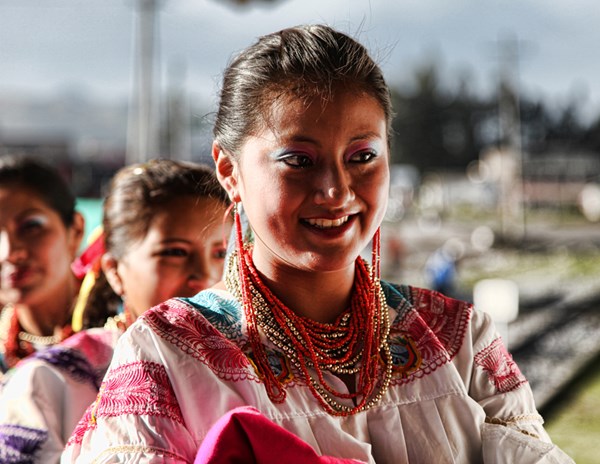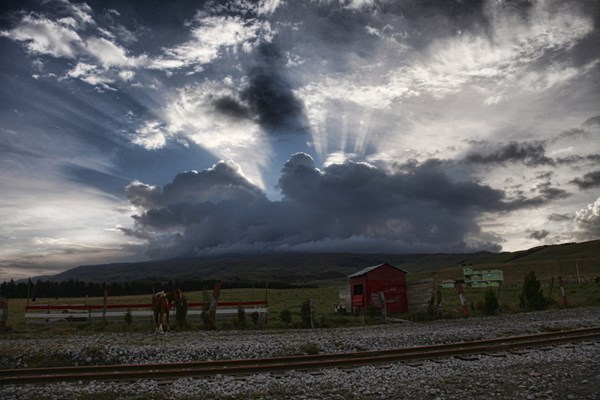QUITO, Ecuador, Aug. 14, 2013 (GLOBE NEWSWIRE) -- Posicionarte, a travel & PR media agency, was invited to discover the brand new Ecuador's cruise train trip 4 days 3 nights from the Andes to Coast, it's travel editor Andrew Taylor meets the descendants of the Quichua de la Sierra.
Balthazar UshcaTenezaca,79, considers himself "the last hielero of Chimborazo". Twice a week, with his donkey (and sometimes his daughter) he climbs the volcano, carves blocks from the glacier and returns with 90lb of ice. He sells it for $10. The demand for glacial ice has dropped since refrigeration, whereas once, it was a mining industry and the train line took the ice to the coast to keep things cool. There are now only two markets that buy and sell ice from the glacier. The ice used to be at the bottom of the mountain where Balthazar and his family live. Now it takes a climb of a thousand metres, four hours to ascend and three and a half to descend. The donkey is slower on the way down. As they walk, they pray.
Chimborazo is the highest mountain in Ecuador, peaking at an elevation of 6,268 metres. To give you a sense of its remoteness, in 1976, SAETA Flight 232 disappeared on route between Quito and Cuenca, carrying 59 passengers. The wreck was found twenty six years later, at 5,400m, suffice to say, there were no survivors.
Chimborazo volcano is surrounded by the Reserva de Produccion Faunistica, a protected ecosystem preserving wild llama, alpaca, camelids and vicuna. The volcano is an emblem of national pride, featured on the Escudo (the Ecuadorian Coat of Arms) along with a Condor in full wingspan.
It's a popular climb and the best seasons are between December – January and July – August. There are two functioning huts; the Carrel Hut at 4,850m and the Whymper Hut at 5,000m. Andrew recommends "Never attempt the climb without a guide. For her exceptional knowledge and wisdom, I recommend climber, novelist and guide, Maria del Carmen Garces".
When the Spanish arrived in 1534, it coincided with a rare eruption of the volcano. The locals, from whom the mountain was a God, took this as a sign to not resist the conquistadores.
Ferrocarrile's scenic train cruise, takes us from the Highland city of Quito to the "Pearl of the Pacific" Guayaquil. You trundle through paramos and chilly nevados, volcano spotting and are treated to excursions, fragments of a unique culture. You visit a Hacienda built around an Incan church where llama come running into the courtyard for you to feed them carrots.
You watch a folk dance, in full traditional costume, that could be interpreted as a potted cultural history up to the Spanish Invasion. The first two dances are expressions of thanksgiving to the Sun and Mother Earth, a direct honouring of the elements that have sustained the highlanders' modest survival. The third was a touching, intimate performance honouring motherhood, and the last, the dance of the vaca loca (mad cow), a choreographed bullfight.
You dine and sleep in colonial haciendas. More often than not your meals are accompanied by live music and by the second day you won´t be able to get the words of "El Condor Paso" out of your head.
"I'd rather be a sparrow than a snail..." Andrew says.
"My favourite sleep-over is Hacienda La Cienega. Built on a swamp (escaping destruction from volcano eruptions and earthquakes) it is rumoured to have once been an Incan burial site." The architecture alone says much about the relationship between the colonials and their outside world. It has this long, intimidating entrance lined with giant, fragrant Eucalyptus trees. The grand facade is daunting, three floors high, a huge door, huge windows and a "statesman's" balcony above it.
One can imagine this regal family with a new born boy, showing their child to the villagers who were paid to turn up and wave. Behind this is a cloistered garden with a central fountain, and paths out like compass points. Andrew's bedroom was next to the church. "I woke at 6a.m. and went to the garden to take pictures." There are sounds of breakfast preparation from the kitchen. Intermittently, someone scurries out with a tea towel in their hand, genuflects and takes a few moments, kneeling in prayer.
The Master's Room with the balcony is recommended, if you can get it. Be sure to make a speech or two to your party. You would rather be a hammer than a nail, right?
The staff are fascinating, because most of them are direct descendants of the original servants. The baristas tell a good tale of monk torturers and guests who have felt strangulation sensations in the night. Think Laurel and Hardy. My waiter at breakfast took me around the house and gardens and told me about his family's history. His father worked in the cheese factory at the back of the building. His Grandfather worked with the beef cattle in their pasture. He showed me the original entrance (towards the village) and talked of the benevolence of the Lady of the House, and the parties where the whole village were invited to feast.
The indigenous market at Guamote is a humbling experience. While elsewhere people are filming us on their phones. Here, everyone ignores them. Eye contact is short and slight. It's almost as if they had been instructed to not bother them. So you have this kind of dance of self-consciousness knowing that they are all watching you, when you are not watching them. Here you see the subtle ancestral threads (descendants of the Puruha culture) in a patchwork of clans. The men have different designs of woven ponchos that (like Celtic tartan) identify the community that one comes from. Andrew says: "I liked the pig market especially, where the going rate for a big ready-to-slaughter-porker is $40. Unfortunately, you can't take it on the train with you".
"If you're concerned that this experience might be too rustic for you" Andrew explains, "let me set the record straight. The accommodation is fantastic". Andrew has told us about the Swamp hotel, the next night's stay is Abraspungo, near Riobamba where the food is exquisite and the beds are so divinely comfortable that you really don't want to leave. The last night is spent at Hacienda Eternal Spring, where at a much more temperate climate we dined by the pool and danced the night away under the stars. To discover more about the Andean Cruise Train excursion - route around the website: http://www.ecuadorbytrain.com/trainecuador/crucero/web/ecuador-train ">http://www.ecuadorbytrain.com/trainecuador/crucero/web/ecuador-train
Photos accompanying this release are available at:
http://www.globenewswire.com/newsroom/prs/?pkgid=20491
http://www.globenewswire.com/newsroom/prs/?pkgid=20492

